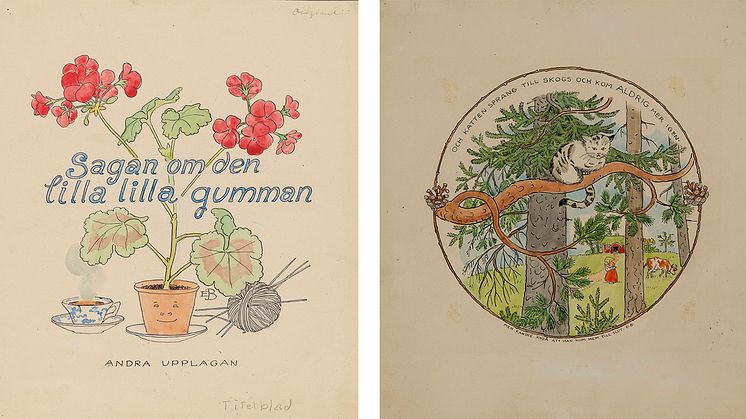
Press release -
Nationalmuseum acquires illustrations for Elsa Beskow’s The Tale of the Little, Little Old Woman
Nationalmuseum has acquired the illustrations for the reworked edition of the beloved book The Tale of the Little, Little Old Woman, created in the late 1940’s. The book was Elsa Beskow’s debut piece and was first published in 1897. Nationalmuseum already has several of Elsa Beskow's illustrations in its collections, for example the book Children of the Forest and several pages from Mors Little Olle and other songs by Alice Tegnér.
The Saga of the Little, Little Old Woman is Elsa Beskow's (1874–1953) debut book and one of the eternally central works in Swedish children’s literature. She has described how she among other things drew inspiration for the book from English designer and illustrator Walter Crane (1845–1915), whose work she had seen at an exhibition in Stockholm in 1896. The book was published for the first time in 1897 and is a personal interpretation of an old folk chant. It contains a cheerful charm and joy which creates a rare and special child feeling, which was rare for those times, in particular through various sound effects such as Moo and Meow.
The book quickly became very popular and it was printed a large number of times and over the years the editions came to change. For example, the title page was revised for the second edition because the artist had married and changed her surname from Maartman to Beskow. The original ending of the saga – "Shoo kitty!!!!" – was perhaps somewhat abrupt, and on behalf of the publisher who remembered the end of the nursery rhyme differently, she later added an additional drawing that described the cat's final fate: "and the cat ran to the forest never to return ".
Unfortunately, Beskow's drawings for the original edition were lost at an early stage. They had been transferred to lithographic pressure stones which, after all of the reprints, eventually became completely worn. Since Bonniers were taking over the release from Wahlström and Widstrand, Beskow in the late 1940’s created new illustrations based on the old printed ones, but now they were created for photographic printing. However, the original for the title page of the second edition was preserved and could be reused in the reworked editions. In the new illustrations, the end of the saga was modified even further and a stanza was added that could possibly put the minds at ease of those who still wondered where old woman's cat disappeared to: "But perhaps he still came home in the end. E.B. ".
The fact that the reproductive technique was now photographic for large editions meant that the richness of detail and hue in alignments and colours was at risk of decreasing, something that was clearly taken into account by the redesigned illustrations. In this way they get a slightly simplified, but at the same time perhaps more immediate expression, which, incidentally, was well matched with the kind of children's book illustration that was fashionable in the mid 20th century.
"We are pleased to preserve an important part of Swedish children's book illustration for the future thanks to this acquisition. The drawings complement other classics by Elsa Beskow, who have been included in the museum's collections for quite some time. Some of the illustrations from The Tale of the Little, Little Old Woman can be seen in the exhibition From Dawn till Dusk, which is on display at Nationalmuseum Jamtli in Östersund starting May 28, says Magnus Olausson, head of collections and research at Nationalmuseum.
Nationalmuseum receives no state funds with which to acquire design, handicrafts and artwork; its collections are enriched through donations and funds from private foundations and funding. The acquisition has been made possible by a generous contribution from the Sophia Giesecke Foundation.
Inventory number:
Elsa Beskow, The Tale of the Little, Little Old Woman circa 1949, NMH 3–15/2019.
For more information
Daniel Prytz, Curator, daniel.prytz@nationalmuseum.se, 08-5195 4306
Hanna Tottmar, Press Officer, press@nationalmuseum.se, 08-5195 4400
Categories
Nationalmuseum is Sweden’s museum of art and design. The collections comprise older paintings, sculpture, drawings and graphic art, and applied art and design up to the present day. The museum building has currently been renovated and reopened in autumn 2018. Nationalmuseum has partnerships with Svenska Dagbladet, Bank of America Merrill Lynch, The Wineagency and the Grand Hôtel Stockholm.

